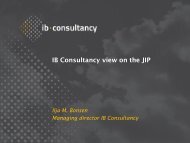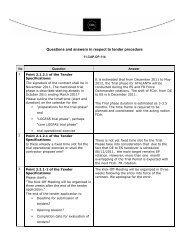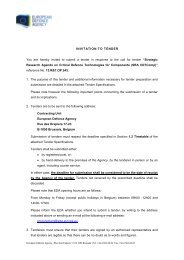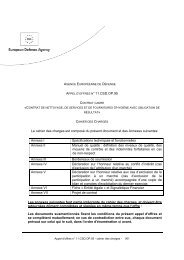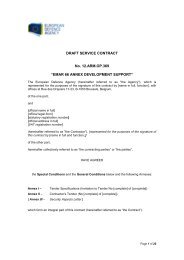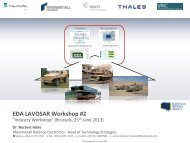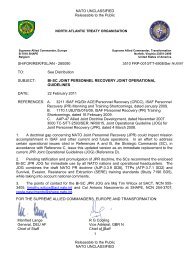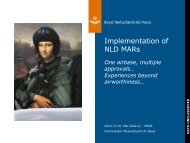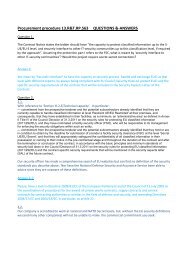capability development plan - European Defence Agency - Europa
capability development plan - European Defence Agency - Europa
capability development plan - European Defence Agency - Europa
You also want an ePaper? Increase the reach of your titles
YUMPU automatically turns print PDFs into web optimized ePapers that Google loves.
STRATEGIC DRIVERS<br />
© EUFOR Tchad RCA<br />
4. Migration movements will continue within Africa and the Middle-East but these may stay within the<br />
same geographic areas and that which does transit to the developed world may be a relatively small<br />
proportion. The control of migration will remain challenging.<br />
5. It is likely that nearly two-thirds of world’s population will be urban dwellers and are likely to be no<br />
further than 200 kilometres from the coast. Many of the largest cities in the developed world are likely<br />
to grow more slowly than the expanding mega-cities (over 10 million) in Asia, South America and other<br />
developing countries.<br />
POTENTIAL SOURCES OF CONFLICT, THREAT AND HUMANITARIAN TRAGEDY<br />
6. Governments and international organisations will be challenged by demographic trends. The<br />
increasingly young population within the developing world, linked with poor economic prospects,<br />
unfilled aspirations created by global media and globalisation, and an uneven regional and local wealth<br />
distribution are likely to lead to tensions and may contribute to future conflict. This is likely to include<br />
inter-communal and inter-ethnic tensions (cf. Culture and Society).<br />
7. Increased populations, pressures on resources and infrastructure, and a failure of authorities to cope<br />
with this growth will create an increased risk of human tragedy in vulnerable areas. This may include<br />
communicable diseases, epidemics, pollution, famine and extreme fresh-water shortages. This is<br />
likely to be made worse by the effects of climate change (cf. Environment).<br />
8. Increased urbanisation will create and exaggerate many issues mentioned above. There may be an<br />
increase in mortality through new viruses and diseases, and a re-emergence of the old ones. Overall,<br />
urbanisation is likely to increase the need for external humanitarian assistance.<br />
9. Enlarged levels of poverty, exacerbated by climate change, will lead to incidences of human tragedy<br />
and is likely to lead to further population displacement. This is likely to provide a breeding ground for<br />
increased organised crime as societies question their traditional civic values and responsibilities to the<br />
state and governmental organisations. This may exploit weak and corrupt governments as well as<br />
consumer markets in growing economies wherever they present themselves. Such exploitation is<br />
likely to be more aggressive.<br />
10. Migration, legal, illegal and forced migration (through conflict and local tensions), is likely to<br />
increase and with it the opportunities for further human catastrophes. Linked to the increased<br />
populations in the developing world, the inadequate infrastructure and poor governance, this may lead<br />
to the destabilisation of existing communities and possibly even states.<br />
POSSIBLE CONSEQUENCES FOR DEFENCE<br />
11. Manpower - Member States will be faced with a serious recruitment problem as a result of the nearstatic<br />
population growth, an ageing population, diseases and direct competition with the commercial<br />
sector. This trend is likely to be exaggerated by extended full-time education and changing attitudes<br />
on single career paths and a desire for variety and flexibility. This will require the military to revaluate<br />
their manpower policies and structures, particularly with respect to retirement age, females and the<br />
employment of migrants.<br />
12. Retention will continue to be a constant pressure on militaries. Changing social aspirations,<br />
competition for skilled manpower for the commercial sector, evolving family values and a desire to<br />
achieve a more balanced work-life ration will challenge the demands of a career in the armed forces.<br />
13. Differentiation of gender-roles will generally diminish but tensions in traditionally male-dominated<br />
societies, such as the armed forces are likely to continue. Although a female role in combat support<br />
and other arms is likely to normalise during the period, their role in actual combat is likely to remain<br />
limited.<br />
14. Migration may provide new possibilities for recruitment and may bring a greater ethnic and social<br />
mixture within the armed forces. However, this is likely to be accompanied by additional education and<br />
training requirements.<br />
15. Training - The theatre of operations will become ever more complicated due to urbanisation, ethnic<br />
35<br />
FUTURE TRENDS FROM THE CAPABILITY DEVELOPMENT PLAN



